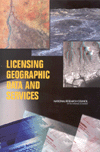
Wisconsin is seeing an increase in both the creation of and demand for geospatial data, as evidenced by the proliferation of public web mapping sites, multiple regional orthophotography projects this spring, and attempts by libraries and universities to provide spatial data access to end users. However, the costs of acquisition and maintenance, perceived liability, privacy, and market considerations have led to a plethora of licensing agreements and data distribution policies around the state.
Recognizing the need for guidance in creating and implementing legally viable, enforceable, and efficient data licensing, as well as determining when licensing is appropriate versus other data distribution mechanisms (e.g. direct sale), the National Research Council (NRC) created a committee charged with producing a report on the licensing of geographic data and services by governmental agencies. William Holland of GeoAnalytics, Inc., a Madison-based information technology services firm, served on the committee and presented a synopsis of the report to Wisconsin Land Information Association (WLIA) conference attendees in February.
The NRC committee’s primary task was to examine various methods of licensing and distribution of geographic data, and see how well current or proposed methods serve agency, commercial, and public needs. As part of this task, they explored case studies and presented a list of recommendations. The intent of the report was not just to catalog experiences and weigh the pros and cons of various licensing models, but also to propose strategies that promote spatial data use and accessibility to all stakeholders.
The list of findings was extensive; economic, legal, and societal issues were addressed in the context of government, commercial, public, and academic environments. The conflicting goals of the many stakeholders, and changes in the technical and legal environment surrounding digital data distribution, have led to uncertainty about which distribution models to use. Many of the report recommendations stress the fact that licensing and distribution decisions should be more than an afterthought; they should involve careful consideration of agency goals and public needs, as well as economics. Other recommendations include the development of standard licensing practices to make enforcement and administration easier, and facilitation of knowledge-sharing regarding licensing experiences.
A final set of recommendations involve the creation of a National Commons and National Marketplace for geographic information. These would be places where individuals can post and acquire data in the common domain and licensed domain, respectively. The report mentioned The National Map, Geospatial One-Stop, and the NSDI as first steps in this direction. The committee also recommended the geographic data community consider ways to encourage data being moved from the licensed to the commons domain. One web site given as an example of the commons idea is http://creativecommons.org/, a site focused on the dissemination of creative works to a wide audience while allowing for individual copyright and licensing options.
What’s happening in Wisconsin?
The WLIA presentation ended with a report by Lea Shanley from the Land Information and Computer Graphics Facility at the University of Wisconsin-Madison on a survey of data licensing practices in Wisconsin. Through the Wisconsin Land Information Program annual survey and a series of 11 case study examinations, she found a wide range of licensing practices among local, state, and federal agencies. In many ways what she found was a reflection of the muddled national picture that motivated the NRC committee’s creation. With no common guidelines or structured ways to share practices, each agency has to find out on its own what does or does not work. Brown County, a case study example, historically tried to recover costs and maintain ownership of their geographic data. But due to the cost of distribution and market considerations they are now shifting towards a less restrictive model that reduces their distribution overhead and encourages public use of their data.
“Cost recovery” often fails, but other benefits possible
Questions from the audience focused on issues of government cost recovery models and public open records laws. One of the findings of the report was that cost-recovery mechanisms rarely provided for cost recovery, and the cost of running these mechanisms may in fact be higher than the revenue they ultimately generate. It was noted however that cost-recovery may also serve other goals, such as making the large costs associated with data collection more politically palatable, as well as the political benefits of a department being able to list a revenue source on accounting documents. Open records laws do seem to indicate that data should be made freely available when its collection was publicly funded. There are however exceptions; for example, the laws allow for charging for services (e.g. 24-hour web access) or reproduction and distribution costs. Also, agencies may only have specific licensed access that does not allow them to freely distribute the data to the public. Mr. Holland is a practicing attorney in Wisconsin, but despite continued badgering by the audience, he was understandably reluctant to make any official legal recommendations!
The WLIA presentation was only a brief overview of the final NRC report. The full 300 page report, which includes guidance for when and how to use licensing as well as sample licensing models and contracts, is available free online at http://books.nap.edu/catalog/11079.html.
